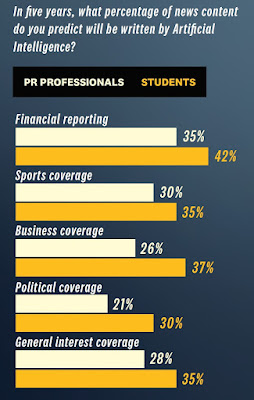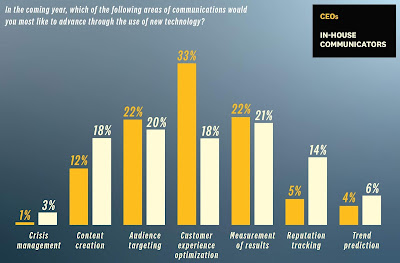The “USC 2019 Global Communications Report” examines the impact of technology on society and the communication industry. This post summarizes the findings regarding news content written by AI, tech tools for PR, leading platforms, required tech skills, and the negative impact of tech changes.
Every year, the USC Annenberg School for Communication and Journalism takes a fresh look at the topics and trends shaping the future of the Public Relations industry. Each time we survey professionals working in the field, we discover new insights into what makes PR one of the most dynamic professions in the universe. This year was no exception as we examined the impact of communication technology – what it means for the industry, academia, and society.
In the previous post and this one, I’m providing a glimpse into this new “PR:tech” report findings. The report is based on a comprehensive survey of more than 2,100 public relations leaders, CEOs, and students worldwide.
The rest of the report is available for download at https://annenberg.usc.edu/gcr.
Educators can request printed copies for classroom use by emailing usccpr@usc.edu.
So, let’s dive into some of the results and insights:
News Content Written by Artificial Intelligence
PR professionals recognize that artificial intelligence is altering the media landscape, but they don’t realize how quickly it’s happening. They predict about 35% of financial reporting will be written by robots in five years, but Bloomberg reports that 30% of their financial stories are already developed by AI. Students predict a greater percentage of robot journalism in the future, but even they may be surprised by the pace of change.
 |
| USC 2019 Global Communication Report: https://bit.ly/2Gb33AL |
Bloomberg uses a system called Cyborg, which according to The New York Times, is able to assist reporters in churning out thousands of articles on companies’ earnings each quarter. The program can dissect a financial report the moment it appears and spit out an immediate news story. In addition to covering earnings for Bloomberg, robots report on minor league baseball for The Associated Press, high school football for The Washington Post, and earthquakes for the Los Angeles Times. These machines aren’t yet replacing reporters, but they are helping them modernize the more mundane aspects of their jobs.
As AI technology spreads, the PR industry will learn how to write press releases that optimize algorithms to ensure the most accurate, positive outcome possible (by the way, fancy diagrams don’t compute). In a few years, PR robots may pitch media robots, but will they meet for lunch?
Main Objectives for New Technology
Tech is also important at the top of the organization. Asked what aspects of their communications they would like to advance through future technology, the vast majority of CEOs stuck with tangible business goals. One-third chose customer experience optimization as a primary objective, which opens a whole new area of opportunity for PR professionals – CXPR, where discrete communication is built into each interaction a customer has with a brand.
 |
| USC 2019 Global Communication Report: https://bit.ly/2Gb33AL |
Customer experience was followed by audience targeting (22%) and measurement of results (22%), which are the beginning and end of that journey. Less clear-cut activities like reputation tracking, trend prediction, and crisis management were chosen by fewer than 5% of the CEO respondents.
In-house communicators are also planning to marshal technology around the customer. Measuring results is their main objective for new technology, which may finally quantify the real impact of storytelling.
 |
| USC 2019 Global Communication Report: https://bit.ly/2Gb33AL |
Marketing and measurement continue to surface as the key factors in driving the adoption of new technology. The competitive environment is also a big factor for PR agencies who now regularly compete with ad agencies, digital firms, and management consultants, all with deep roots in tech.
Current Ability to Use the Latest Technology
It’s clear that technology has become a critical component of corporate communications for today’s CEOs, and many are relatively pleased with the results. 44% of CEOs surveyed rate their company’s use of the latest communication technology as excellent or good, with 46% admitting to average or below. In-house communicators give themselves significantly lower scores, while agencies think they are more advanced.
 |
| USC 2019 Global Communication Report: https://bit.ly/2Gb33AL |
All three groups view new technology as a valuable investment in achieving their future business goals, but experience says we have a long way to go.
Importance of Technological Tools –
Current Work vs. Future Work
The number of tools available to the PR professional is growing exponentially. But few are viewed as very important to the communications work currently being done. In fact, media monitoring services like Cision and Zignal Labs, which have been around for years, are ranked as important tools being used today and tomorrow.
 |
| USC 2019 Global Communication Report: https://bit.ly/2Gb33AL |
By contrast, newer technologies – like Virtual Reality, Augmented Reality, and Voice Assistants – are not considered important to current work by roughly two-thirds of PR executives. Customer Relationship Management, Search Engine Optimization, and Web Analytics fall somewhere in between and the importance of those tools is expected to increase dramatically in the coming years.
 |
| USC 2019 Global Communication Report: https://bit.ly/2Gb33AL |
Social media tools show the biggest jump in importance from the present to the future, which tracks with the growing importance of that media channel. Over half of the respondents expect social listening and influencer identification platforms will be very important tools for PR professionals in the future.
Artificial Intelligence and the PR Industry
Interestingly and perhaps alarmingly, only 18% of all PR executives believe artificial intelligence, which is being heralded as the next big thing, will be a very important technology for them in the future.
 |
| USC 2019 Global Communication Report: https://bit.ly/2Gb33AL |
But that may be because only 3% claim to be very knowledgeable about potential AI applications.
 |
| USC 2019 Global Communication Report: https://bit.ly/2Gb33AL |
Most PR people are confused by the concept of artificial intelligence.
Futuristic visions of “Terminator,” “Blade Runner,” and “Ready Player One” can be scary, but that world is a long way off. Today, without even realizing it, we’re using AI every day for many mundane activities: asking Siri about the weather, receiving a recommendation from Amazon, or requesting an Uber X. These tasks are made possible by machine learning.
For the communications profession, AI is mainly an analytics tool that allows us to do quantitative analysis of massive amounts of data – with the hope of making our strategies smarter, our results better, and our jobs easier.
Most of the tools listed in the glossary of this report (also here) are built on some form of artificial intelligence, and they will profoundly change the way we think and work.
The PR industry will benefit from artificial intelligence, but we must also be aware of its drawbacks. Open AI, a non-profit research organization founded by Elon Musk and Sam Altman, recently developed a transformer-based language model called GPT-2, which is trained to predict the next word based on all the previous words in a text. Given a simple prompt, the model is capable of generating a page or two of human-quality text. Despite the technology’s potential business applications, Open AI has declined to release the latest version to the public, citing a concern that it might be used to “develop deceptive, biased or abusive language at scale.”
Meanwhile, Gltr, an MIT-IBM Watson Lab/Harvard NLP joint project, analyzes texts and predicts whether it was written by a machine.
The Leading Communications Platforms
When it comes to communications platforms that will be most important in the future, pictures tell the story. YouTube and Instagram, whose popularity is based on photographs and videos, are projected to be the big winners in an era of decreasing attention span.
Google, an AI leader offering a portfolio of technology tools, is not far behind. While visual experiences will rule, text-based platforms may not: A mere 5% feel Medium will be an important communications platform in five years.
 |
| USC 2019 Global Communication Report: https://bit.ly/2Gb33AL |
Due to the greater number of responses from North America and Europe addresses, it’s certain that WeChat and Weibo are under-indexed in these totals.
Those who chose “other” predict the dominant platform of the future has yet to be invented!
Technology Skills for Successful PR
As the PR profession adopts new technology, PR professionals will need to adopt new skills. Machines may do the analysis, but intelligent humans will be required to translate data into actionable insights. Those insights will be expressed visually, which increases the need for production and design capabilities.
 |
| USC 2019 Global Communication Report: https://bit.ly/2Gb33AL |
Contemporary undergraduate PR programs teach coding, analytics, and video production, which means a stream of tech-savvy recruits are coming to the rescue. But the technology transformation must be initiated by corporate and agency leaders, who have the authority and the resources to make it a reality.
Technological Changes in Media will Make Average Citizens More – Engaged, Misinformed, Polarized
PR professionals have a mixed view on the long-term impact communication technology will have on those who are on the receiving end of it. 61% agree that the average consumer of information will become more engaged, which is a good thing. But the same percentage (61%) believe that their engagement will be based on misinformation, which is not a good thing. As a result, almost three-quarters (74%) see society becoming more polarized in the future, which seems impossible based on the divisiveness we are already experiencing today.
Students are more optimistic: Only 43% predict the average citizen will be more misinformed, and 53% say they will be more polarized.
 |
| USC 2019 Global Communication Report: https://bit.ly/2Gb33AL |
These statistics highlight the power of communication technology, especially when employed to promote a controversial point of view or disseminate misleading information. Communications professionals have a profound obligation to use these new tools responsibly and to denounce those who do not.
Importance of Technology vs. Human Capital in the Communication Industry
 |
| USC 2019 Global Communication Report: https://bit.ly/2Gb33AL |
Al Golin wasn’t a fan of social media. He preferred high-touch to high-tech. He believed in building relationships face-to-face rather than on Facebook. But there is no turning back. Technology is our future, and tomorrow’s leaders will embrace it. For a long time, we’ve championed the art of Public Relations. To remain relevant to our companies and our clients, we must combine that art with science.
At the same time, we need to remember that our job is to build relationships. Relationships between companies, brands, and people. PR professionals have unparalleled insight, not shared by any other discipline, into the elements of human connection. We know how to listen, and we know how to tell stories. Technology will enhance these skills, but it will never replace them.
********
About the Global Communications Report
The Global Communications Report is produced annually by the USC Annenberg Center for Public Relations, in conjunction this year with Union Pacific, Worldcom Public Relations Group, Davis & Gilbert LLP, Arthur W. Page Society, Global Alliance for Public Relations and Communications Management, IABC, International Association for Measurement and Evaluation of Communication, International Communications Consultancy Organization, Institute for Public Relations, MCC Consulting, PRCA, PR Council, PRSA and PRSSA. The survey of PR professionals, educators, and students is designed to provide insight into the evolution of the global communications industry.
About the USC Center for Public Relations
Based at the USC Annenberg School for Communication and Journalism, the USC Center for Public Relations (CPR) connects corporations, agencies, academics, and students to define the future of our industry and to develop those who will shape it. Signature initiatives include the Global Communications Report, USC Annenberg’s Kenneth Owler Smith Symposium, and the Relevance Report. Follow CPR @Center4PR and #PRFUTURE.

No comments:
Post a Comment